At last, a fine Mars apparition: on May 22nd the Red Planet reaches opposition, shining almost as bright as Jupiter, and the planet makes its closest approach to Earth on May 30th.
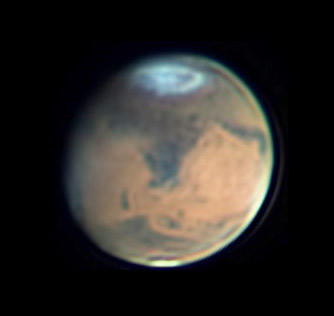
Mars has a reputation as one of the biggest disappointments in a telescope. It spends most of its time far from Earth, and it’s a small planet to begin with. So it’s usually just a tiny, shimmering fuzzball. Mars passes close to us only every 2.1 years around its oppositions, and even then it comes and goes fairly quickly. Moreover, because Mars has a rather elliptical orbit, many of its oppositions are relatively distant.
But now everything is coming together better than it has in 10 years.
We’re currently on the upswing of Mars’s 16-year cycle of oppositions near and far. By April 1st its globe in a telescope reaches an apparent diameter of 11.9 arcseconds, enough to show surface features fairly well in a sharp 4- or 6-inch telescope during excellent seeing. By May 1st Mars is 16.1″ wide, and when it tops out for the week around May 30th, its closest-approach date, it will appear 18.6″ across. Seen in a 200× eyepiece, that’s like a ping-pong ball 7.2 feet (2.2 meters) away. Not bad.
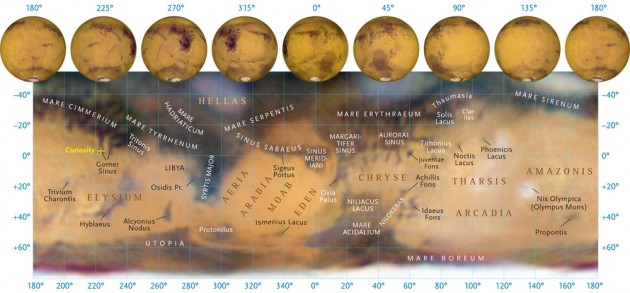
Sky & Telescope diagram
Opposition comes eight days earlier, on the 22nd, when Mars will shine at an almost Jupiter-like magnitude –2.1. Mars remains larger than 14″ all the way from April 17th to July 21st.
But there’s a catch. This season Mars is fairly far south, in or near the head of Scorpius around declination –21°, so it will never get very high for those of us in the north temperate latitudes.
As always, give your telescope plenty of time to cool to the surrounding air temperature before expecting good views at high power. Observe often to catch nights of fine seeing. And spend lots of time watching for everything on Mars that is possible to glimpse; more comes out with time.
Here are some things to look for:
The Polar Caps
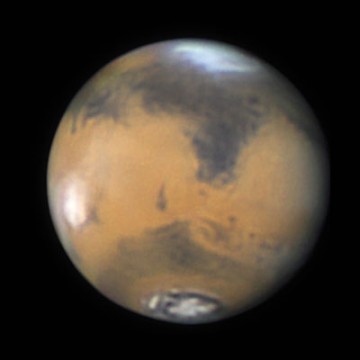
Damian Peach
We see Mars nearly equator-on this season, with its north pole tilted only slightly into our view and the south pole tilted slightly away. Mars’s northern hemisphere is currently in the height of its long summer (which runs from January 3rd to July 5th this year), so in April and May the North Polar Cap should already be very small and continuing to shrink. The Martian southern hemisphere is having winter, so the edge of the South Polar Hood of winter clouds may peek into view around the planet’s southern limb. The southern cloud hood should be larger but probably less brilliant white than the North Polar Cap. As always, tell celestial north and south in your eyepiece view by nudging the scope in the direction toward Polaris; new sky will enter from the view’s north edge.
Albedo Features
The Martian surface markings — the dark “maria” and bright “terrae,” with their picturesque classical names given by Mars mappers in the late 19th and early 20th centuries — are merely differences in the average reflectivity (albedo) of the surface rock, sand, and dust. Windstorms sometimes move the dust, resulting in both seasonal and long-term changes. Syrtis Major, the most prominent dark marking, has undergone a dramatic, long-term widening since the 1950s. It also shows lesser seasonal changes in width: It tends to be widest in the northern hemisphere’s mid-summer, meaning now.
The area around Solis Lacus, sometimes called the “Eye of Mars,” is notorious for changes in surface markings. So is the Elysium region.
Clouds and Hazes
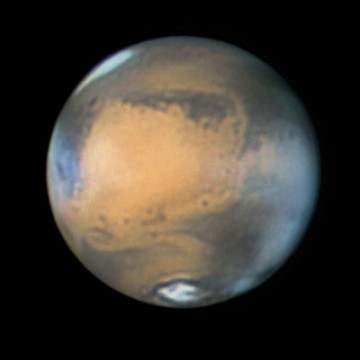
Damian Peach
The Martian atmosphere is ever-changing. Look for white water-ice clouds and bluish limb hazes. Bright surface frosts also occur; these are hard to tell from clouds. As ice in the North Polar Cap sublimates through the northern summer, the atmosphere gains more water vapor and clouds become more frequent planet-wide.
Discrete clouds often recur at the same places, especially Hellas, Chryse, and Libya. The “Syrtis Blue Cloud” circulates around the Libya basin and across Syrtis Major; it’s best seen when these features are near the limb. Viewing this bluish cloud through a yellow filter may cause Syrtis Major to appear distinctly green.
Orographic clouds sometimes form over windblown Martian mountains, like orographic clouds on Earth. Enormous Olympus Mons and the three other shield volcanoes of the Tharsis plateau are especially prone to them. So is Elysium Mons in Elysium on the planet’s other side.
Limb brightenings (“limb arcs”) are caused by dust and dry-ice crystals scattering light high in the Martian atmosphere.
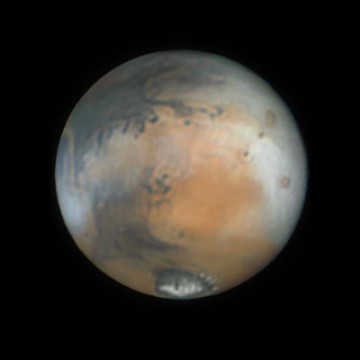
Damian Peach
Morning clouds are bright, isolated patches of surface fog or frosty ground near the morning limb (the celestial east or “following” side). Fogs usually dissipate by midmorning as Mars rotates; frosts may persist for most of the day.
Evening clouds have the same appearance as morning clouds but occur on the planet’s preceding limb.
Dust storms can occur in almost any Martian season, but they’re uncommon during southern-hemisphere winter, meaning now. The critical diagnostic of a dust storm is a relatively bright patch moving and obscuring dark features that were previously well defined. Dust storms may change appearance from one night to the next.
Which Side Are You Seeing?
One side of Mars is fairly blank; the other is more feature-rich. To identify surface features you see in the eyepiece, you’ll need to know what side of Mars is facing you.
To find out, enter the time and date when you plan to observe into S&T's Mars Profiler. Choose the correct orientation to match your telescope, and compare the map section you get you to the map and disks printed at left.
Out observing, you’ll find that Mars presents nearly the same face from night to night. This is because the Martian day is only 38 minutes longer than Earth’s. To see other parts of Mars, you have to observe at a different time of night, travel to a different longitude on Earth, or wait for a week or more to pass. If viewed at the same time of night from the same place, Mars takes somewhat more than a month to complete one retrograde (backward) “rotation.”
Get a complete view of Mars with our detailed Mars globe, which includes official names for 140 features on the Red Planet.
For More Information
| Live webcasts: On May 22nd and 30th, Gianulca Masi's Virtual Telescope Project will host online webcasts featuring telescopic images of Mars. Both begin at 22:00 Universal Time (6:00 p.m. Eastern Daylight Time). |
Jeff Beish offers his detailed rundown of this Mars apparition, with a calendar of what to watch for as the Martian seasons change through 2016, at Alpo Astronomy.
The next opposition of Mars will be even better. Mars will be at the peak of its 16-year opposition cycle, and when it’s closest to Earth on July 31, 2018, it will be 24.3″ in diameter. That’s nearly the maximum possible: 25.1″, which Mars attained in August 2003.
This article first appeared in print in the April 2016 issue of Sky & Telescope. Subscribe today and never miss another celestial event!
 6
6









Comments
Robert-Casey
May 17, 2016 at 3:17 pm
Time for another round of dumb "Mars as big as the Moon" newspaper articles... 🙂
You must be logged in to post a comment.
Tom Hoffelder
May 18, 2016 at 8:43 am
Regardless of when Mars comes to opposition, those emails (I never saw it in a newspaper, but then I don't do news) come around in August of every year!
You must be logged in to post a comment.
Bob
May 17, 2016 at 10:46 pm
Alan...
Thanks for an interesting article posted here and in the April 2016 issue of S&T. I particularly like the map to identify surface features.
...Bob Patrick
You must be logged in to post a comment.
Redflicker
May 18, 2016 at 9:34 pm
I must agree, learned a lot. Visuals just great.
You must be logged in to post a comment.
Scott
May 20, 2016 at 4:23 pm
The "Mars Profiler" should support various date formats other than "mm/dd/yyyy" (especially ISO "yyyy-mm-dd"). Most built-in date parsing functions support multiple formats automatically (if non-ambiguous), so that should be a pretty easy fix.
You must be logged in to post a comment.
Randall Osczevski
May 22, 2016 at 7:45 pm
I looked for Percival Lowell's canals in Christopher Go's photo, but I can't see them. However, across Tyrrhena Terra to the crater Huygens (between Syrtis Major and Hellas) I can clearly see giant letters like graffiti that read "RH:5"
No wonder Lowell thought he saw canals.
You must be logged in to post a comment.
You must be logged in to post a comment.